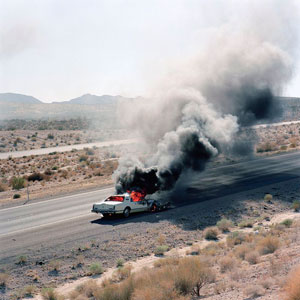11.6.24 — Nothing Wrong
There is nothing wrong with an empty table in a diner. The waiter has set it for customers, and who knows but it is about to receive them.
Jeff Brouws, for all I know, may have asked them to wait while he snaps a photo. And if salt, pepper, cream, and ketchup are not your idea of sophisticated tastes, that is what diners then were for. You may still think of them as creature comforts. If the standard-issue black ashtray would look out of place today and a bit of a turn-off, this was the early 1990s, and Brouws often leaves hints of time and place in the most innocuous of settings. 
There is nothing wrong either with a single car in an otherwise empty lot. An employee at the mall might have been early getting in or late getting home. Americans work hard, right? Yet it can only be a portrait of its time and of emptiness, much like the diner. Blame Joe Biden if you like for the American unease that could easily have turned the election to Donald F. Trump, or blame the media and right-wing propaganda in a time of unprecedented prosperity. Brouws, though, knew an earlier time when crime had only begun to fall and unease was anyone’s right. He, in turn, can take credit for photographing it. He can take even more for seeming to do so without really trying, at Robert Mann through December 6.
You may still think of malls as creature comforts, too, even as they fall victim of e-commerce. Just do so at your own risk. And Brouws photographs a world of impulse buying, even as impulsive acts lead to disaster. A car stands trapped in its own smoke and fire on the highway. The neon glow of a motel at night looks frighteningly cold. Could this have been so cold and so dangerous a time?
It could be almost anything. Back in Chelsea after the pandemic, the gallery calls the show “Just About Everything, Someplace Else,” after two photographs of spray-painted walls. The photographer, it says, has an eye for just about everything, but there is always that unsettling someplace else. He crosses America to find it, much like Robert Frank or Lee Friedlander. Unlike them, he works in color. He must relish the darkness of smoke and the brightness of fire, all but ordering you not to look away.
Unlike them, too, he all but omits people. Frank had his landmark with The Americans, but here Americans are present by what they leave behind. Bars and storefronts are at least partly boarded up, but you may still look inside to see what they were selling. With luck, the driver and passengers escaped a burning wreck. Come to think of it, a worker at the mall would probably claim a spot closer to the stores, not dead center. The car really could be abandoned, or it could take that much more care for its place.
Regardless, the work speaks of its time, between spray paint as urban blight and as entering the museum. If those slogans are graffiti, they are neatly executed. There may be tragedy on the highway, but also comedy in a car at a forty-five degree angle to an untended field. There may be beauty in a jazz singer and her unheard melodies. Titles spell out the location of each one. They want you to remember everything and something else.
Read more, now in a feature-length article on this site.